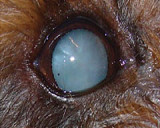Remember that cataracts are not benign, developing and mature cataracts leak previously sequestered lens proteins. This can cause lens induced uveitis (LIU). Diabetics seem to be especially prone to developing LIU. We always use topical and or systemic anti-inflammatories to prevent or treat LIU.
Treatment
If the eye is otherwise healthy we often use Prednefrin Forte or Maxidex topically to treat LIU. If there is significant LIU present then we will also use oral anti-inflammatories usually oral NSAIDs. If the cornea is unhealthy e.g. corneal ulcer, lipid then systemic anti-inflammatories can be used.
For developing cataracts warn the owner to watch for a RED EYE, this would be perilimbal hyperaemia which with a cataract would suggest LIU. Generally LIU develops after the cataract is well developed. For diabetics we do not wait for the cataracts to develop before starting treatment. It is our experience that topical cortisones do not affect the treatment or stabilisation of diabetic dogs, however if concerned then topical NSAIDs can be used in most cases to prevent LIU developing. liu Severe LIU, note the deep PLH, pigment on the lens.
This eye was enlarged, the IOP was 43mmHg
Lens Induced Uveitis (LIU)
Why worry about Lens Induced Uveitis (LIU)?
LIU will reduced the success rate of canine cataract surgery. LIU if untreated will lead to luxation of the cataract and or secondary glaucoma. The low grade uveitis will damage the zonules (which normally hold the lens in place) to break, meaning the cataract will luxated either anteriorly or posteriorly into the vitreous. Glaucoma can develop from the anterior luxation or the cataract or more commonly from lens protein, inflammatory cells and preiridal fibrovascular membranes blocking the iridocorneal drainage angle.








